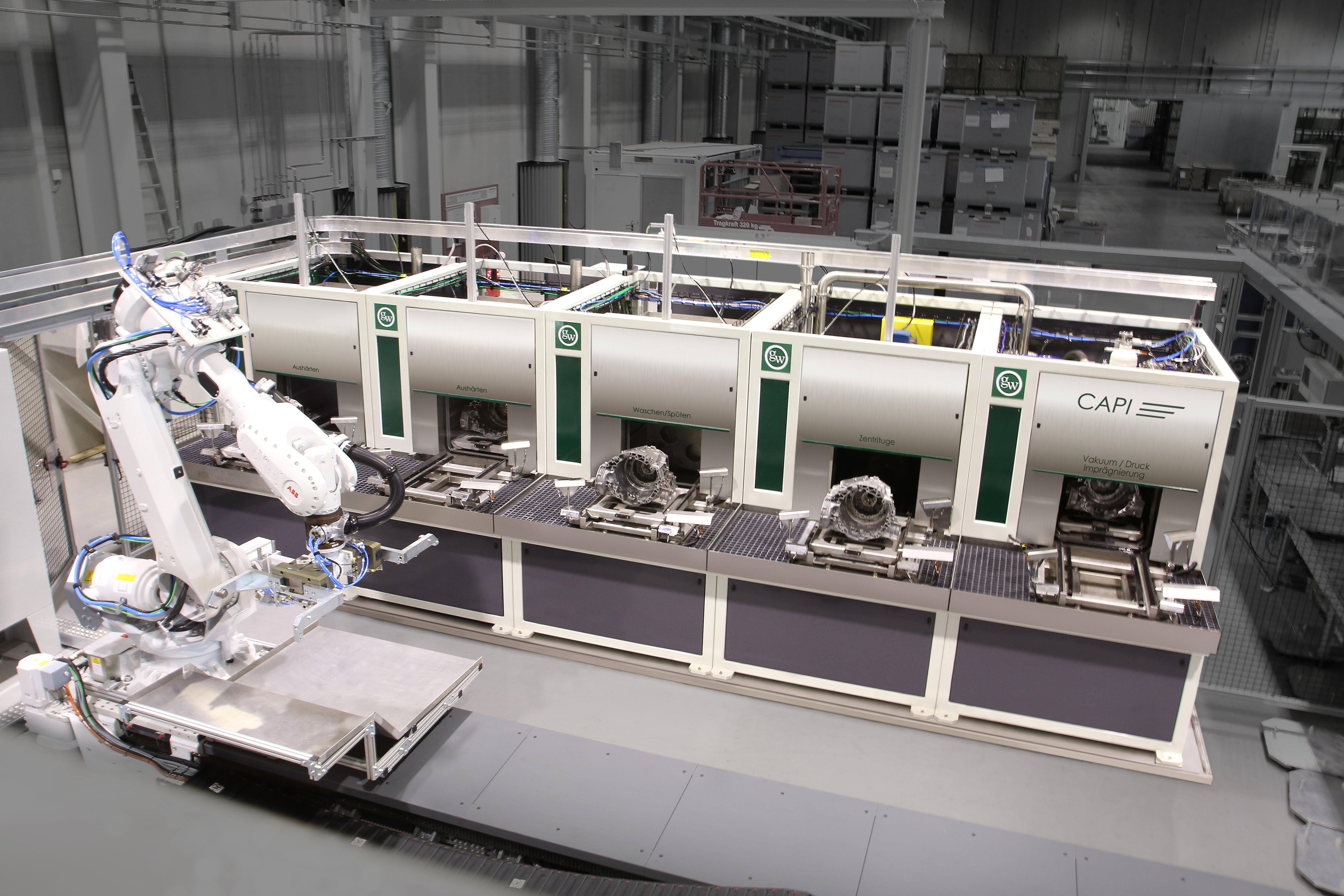Vacuum Impregnation Equipment
The decision on the style of equipment is determined on what fits best in your manufacturing environment and supports your impregnation process. Today there are a variety of impregnation systems available. Systems vary in size, flexibility, controls (manual or automated), integration with upstream or downstream processes.
Both manual and automated systems generally have the same four components:
- Vacuum / pressure autoclave
- Drainer / centrifuge unit
- Washing / rinsing station
- Curing station
Manual VacuumImpregnation Systems
The manual systems (Fig. 1, Godfrey & Wing) represent modern technology with a smaller footprint. These systems are cellular or lean in design, focused on conserving resources including labor, power and floor space while being very ergonomic. The individual stations are loaded from the front, eliminating the need for overhead hoists and cranes. These systems impregnate smaller load sizes or single components per impregnation cycle. This allows reduction for efficient and effective process times and the cleanliness of the components is much better than with batch systems.
These systems can process parts as large as V-8 engine blocks and transmission cases. The lean footprint of these systems allows them to be integrated with other operations, such as machining of leak testing. This integration allows for continuous production flow and elimination of WIP. The DVP and DV, impregnation processes can be used in a modular system.
Automated VacuumImpregnation Systems
An automated system (Fig. 2, Godfrey & Wing) takes it one step further. This impregnation system is front loading as well but operated with a robot. Like manual systems, robotic impregnation systems process parts individually. Robotic systems offer shorter cycle times and eliminates any variation in process associated with labor. DVP and DV impregnation processes can be used in a robotic system.
When selecting which style of equipment to purchase, consideration should be given to:
- WIP
- Logistics
- Handling
- Throughput
- Maintenance
- Allotted space
- Pressure test strategy
- Manufacturing strateg
Vacuumimpregnation is increasingly being carried out internally in the company. There are the following reasons for this:
Reduce Cost
In-house impregnation can be done at a fraction of the piece price for an outside service company. Modern equipment uses minimal labor, is small and compact, and is stingy with resources, including sealant and utilities.
Maintain Safety
Modern impregnation equipment has a variety of features to keep the operator safe. Self-contained modules protect the operator from contact with sealant and hot fluids. Mist eliminators collect water vapor in the exhaust and return it through a drain line for re-use. Better ergonomics allow the operator to slide a lightweight fixture onto the platform for each module.
Logistics
By operating equipment in-house, companies can eliminate all the costs associated with freight, handling, and inventory. Also, companies will have better lot control and part traceability. Lot traceability is imperative to produce parts efficiently. Having lot control and part traceability measures in place means saving money in the long run, protecting the company from recalls and lost inventory, and keeping the company in compliance with standards and regulations.
Production Integration
Both the size and the modular design of impregnation systems enable manufacturers to position the system within the machining, testing, or build areas, placing the solution where it is needed.
Quality control
Vacuumimpregnation equipment uses automated and repeatable processes to increase recovery rates and eliminate handling damage. Robotic part handling impregnates parts automatically while reducing the possibility of human error. Stations contain HMI controls cycle status lights that present process data and fault diagnostics.
A decision on the system of equipment is determined on what fits best in the manufacturing environment. Today there are a variety of impregnation systems available. Systems vary in size, flexibility, controls, integration with upstream or downstream processes.
The two main styles of equipment are manual and robotic.
Manual systems
The manual systems (Fig. 1, Godfrey & Wing) represent modern technology with a smaller footprint. These systems are cellular or lean in design, focused on conserving resources including labor, power and floor space
while being very ergonomic. The individual stations are loaded from the front, eliminating the need for overhead hoists and cranes. These systems impregnate smaller load sizes or single components per impregnation cycle. This allows reduction for efficient and effective process times and the cleanliness of the components is much better than with batch systems
These systems can process parts as large as V-8 engine blocks and transmission cases. These systems' lean footprint allows them to be integrated with other operations, such as machining of leak testing. This integration allows for continuous production flow and the elimination of WIP.
Robotic systems
A robotic system (Fig. 2, Godfrey & Wing) takes it one step further. This impregnation system is front loading as well but operated with a robot. Like modular systems, robotic impregnation systems process parts individually. Robotic systems offer shorter cycle times and eliminate any variation in the process associated with labor.
Additional references:
Centrifuge
Washing station
Curing station
Impregnation chamber
Impregnating agent



